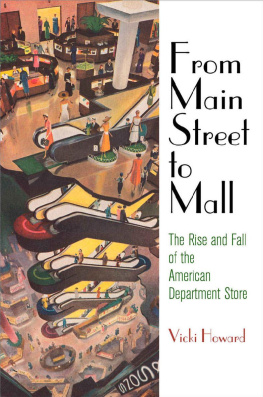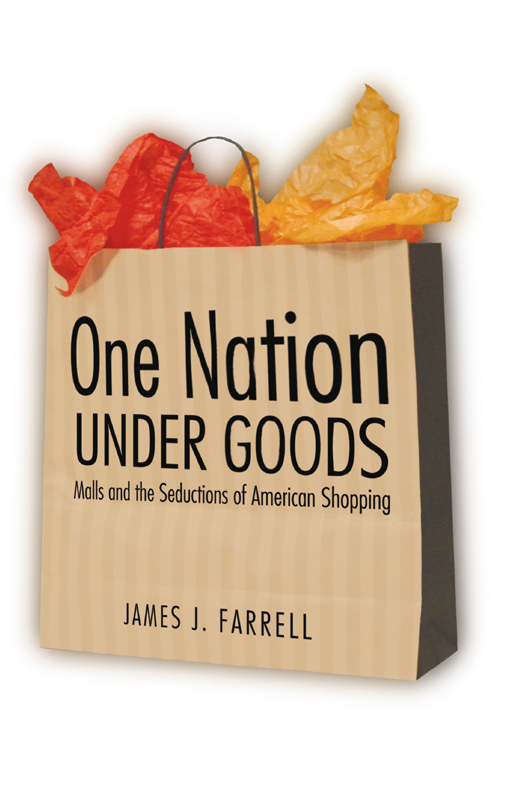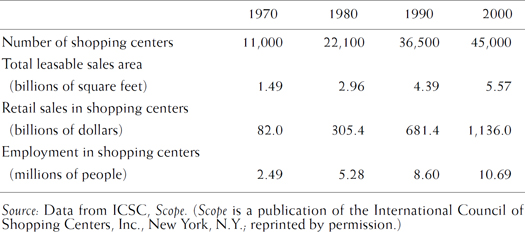2003, 2010 Smithsonian Institution
All rights reserved
Copy Editor: Karin Kaufman
Production Editor: Ruth G. Thomson
Designer: Brian Barth
Library of Congress Cataloging-in-Publication Data
Farrell, James J., 1949
One nation under goods : malls and the seductions of American shopping / James J. Farrell.
p. cm.
Includes bibliographical references.
ISBN 1-58834-152-6 (alk. paper)
eBook ISBN 978-1-58834-433-5
1. Shopping mallsUnited StatesHistory.
2. Shopping centersUnited StatesHistory.
3. Popular cultureUnited StatesHistory. I. Title.
HF5430.3.F37 2003
381.1dc21 2003041447
British Library Cataloging-in-Publication Data available
For permission to reproduce illustrations appearing in this book, please correspond directly with the owners of the works, as listed in the individual captions. Smithsonian Books does not retain reproduction rights for these illustrations individually or maintain a file of addresses for photo sources.
v3.1
To my students, who are also my best teachers
What would become of us, if we walked only in a garden or a mall?
Henry David Thoreau, Walking
An age that has lost its consciousness of the things that shape its life will know neither where it stands, nor, even less, at what it aims.
Siegfried Giedion, Mechanization Takes Command
Theres a place for fun in your life.
Mall of America
We cannot begin to know ourselves until we can see the real reasons why we do the things we do, and we cannot be ourselves until our actions correspond to our intentions, and our intentions are appropriate to our own situation.
Thomas Merton
The primary task is to design environments where it will be possible for [people] to lead the lives of free and responsible citizens, where they can give expression to the social or political side of their nature.
J. B. Jackson, Landscape

There are many debts incurred in Americas malls. There have also been debts incurred in writing this book about malls. The absent-minded professor will surely forget some of them, but because scholarship is always a community endeavor, it pays to acknowledge our debts.
I am indebted to Americas libraries, especially to the librarians of St. Olaf College. A church-related liberal arts institution doesnt regularly shelve such books as The Shopping Center Development Handbook or Design for Effective Selling Space, but my colleagues in the Interlibrary Loan office have been persistent in finding such volumes for me. And librarians all across the country have been generous with their time and collections.
One Nation under Goods also owes a lot to people who work in malls of America for sharing insights and materials with me. Malls themselves are a visual spectacle, and this books visual dimension is due in large part to people who generously granted permission to reprint photographs and cartoons. Even when people couldnt grant permission for precisely the images I wanted, they went out of their way to help me find materials that would work just as well.
I owe this work to my friends and colleagues at St. Olaf College who have created an intellectual community that makes an eccentric professor like me feel right at home. More specifically, I owe a debt of gratitude to the Faculty Development Committee at St. Olaf, whoat just the right timegave me time (the scarcest of academic resources) for research and writing. I also owe thanks to the college for a timely sabbatical to complete the project.
Im also thankful to the people of St. Joan of Arc, a radical Catholic community in Minneapolis that continually raises my consciousness and engages my conscience. The services at St. Joan are inspiringin every sense of the word. St. Joan of Arc challenges members to think continually about the moral ecology of everyday life and to do something about itchanging the world, in small ways and large, with our own wild and precious lives.
I am indebted to several generations of St. Olaf students, who have been inquisitive and imaginative in thinking about the social construction of shopping in classes on American consumer culture and Minnesotas Mall of America. I owe a lot to Kendra Smith and Kahla Foster, who shared ideas with me for most of their senior year, and Im especially indebted to Laura Henderson and Elise Braaten, whose thoughtfulness, expressed as cogitation and care, never ceases to amaze me.
Many of these reflections have been influenced by Dr. America, the curator of the magnificent (but wholly imaginary) American Studies Museum. Since April Fools Day of 1996, Dr. America has made his home on public radio station WCAL in Northfield, Minnesota. Both the good doctor and I are indebted to program director and grand poohbah Marty Pelikan for his invitation to think about the invisible complexity of American culture and for his careful editing of individual essays. Marty has a way with wordsand with ideasthat makes it a pleasure to put ideas into words every week.
Finally, I owe a debt of gratitude to my family. I am indebted to both of my sons, John and Paul, who read my chapters in addition to assignments from their other professors, and who taught their old man about todays youth culture. And as always, this book belongs to Barb, who has shared my life and work for more than thirty years.

Malls are an American cultural phenomenon. The United States now has more shopping centers than high schools, and in the last forty years, shopping center space has increased by a factor of twelve. By 2000, there were more than forty-five thousand shopping malls with 5.47 billion square feet of gross leasable space in the United States. Currently, Americas shopping centers (most of which are strip malls) generate more than a trillion dollars in annual sales. Not counting sales of cars and gasoline, thats slightly more than half of the nations retail activity. The International Council of Shopping Centers (ICSC) reported that in 2000, Americas shopping centers served 196 million Americans a month and employed more than 10.6 million workers, about 8 percent of the nonfarm workforce in the country. We go to malls 3.2 times a month and spend an average of $71.04 each time (a one-third increase in spending from 1995 to 2000). Shopping centers also support our state and city governments, generating $46.6 billion in sales taxes, almost half of all state tax revenue (see
Table 1
Shopping Centers in the United States
Shopping is such a common part of Americas pursuit of happiness that we usually take shopping centers for granted. But although malls are usually places of consumer forgetfulness, they can inspire a sense of thoughtfulness. Its no particular problem if we come back from the mall empty-handed, but it should be a deep disappointment if we come back empty-headed.












